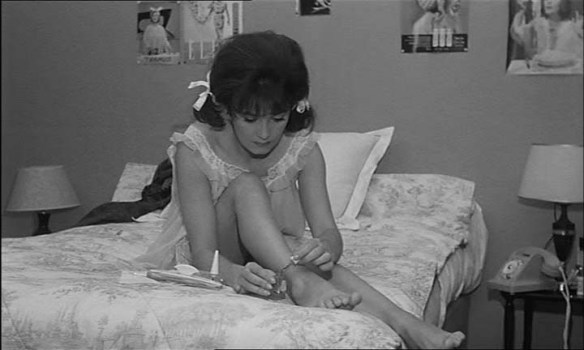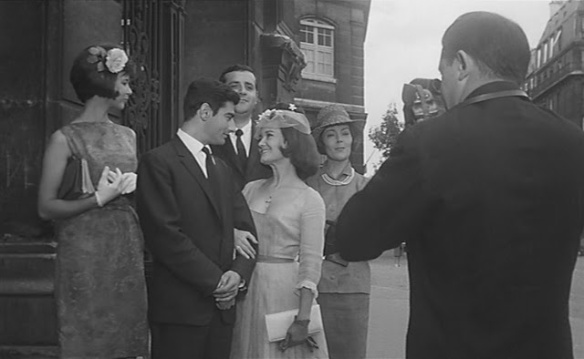Films that explore mental illness, especially Hollywood productions such as The Snake Pit, The Three Faces of Eve and A Brilliant Mind, usually tend to be heavy on the histrionics providing highly dramatic showcases and Oscar award opportunities for actors. But a descent into madness isn’t always signaled by wildly disruptive or overwrought behavior from the afflicted. Sometimes the illness can creep up slowly by degrees and pass for something more fleeting and subtle that avoids detection during the early stages. Life Upside Down (La vie à l’envers), directed by Alain Jessua, is a remarkable example of this, presenting a man who goes quietly mad while interpreting his erratic behavior as a profound new self-awareness.
The 1964 release marked the feature film debut of the 32-year-old filmmaker/screenwriter and is a remarkably self-assured and original first effort that was critically praised by many during its original release. It was nominated for a Golden Lion at the Venice Film Festival and won for Best First Work. It also was in the running for Best Foreign Language Film in the New York Film Critics Circle Awards. Sadly, the film is little-known today and difficult to see on any format although you can stream a less than satisfactory version of it on Youtube where the original aspect ratio is compromised and there are no English subtitles. I recently revisited a DVD-R copy of the film from ETC (European Trash Cinema) and discovered that not only does the film hold up well but grows more intriguing upon subsequent viewings.  Under the credits, we see a portable tape recorder on rewind. The play button is pressed and the narrator, Jacques Valin (Charles Denner), begins his tale: “I can’t say when it started. Thinking back, it must have been about two months ago…” Presented in flashback, Life Upside Down is told from Jacques’ perspective, often sharing his delusional visions and thoughts as his mental breakdown proceeds to a final haunting fadeout.
Under the credits, we see a portable tape recorder on rewind. The play button is pressed and the narrator, Jacques Valin (Charles Denner), begins his tale: “I can’t say when it started. Thinking back, it must have been about two months ago…” Presented in flashback, Life Upside Down is told from Jacques’ perspective, often sharing his delusional visions and thoughts as his mental breakdown proceeds to a final haunting fadeout.
While the tone of the film is often as cool and detached as Jacques’ observations of others and himself, this is not some clinical case study but an unconventional character portrait punctuated with absurd humor, tragedy (a suicide attempt) and urban angst. The striking black and white cinematography by Jacques Robin moves fluidly between the protagonist’s interior and exterior worlds recording selected sociological and psychological details but also capturing his heightened senses in scenes of lyrical beauty. And the sound design of the film reinforces Jacques’ bemused vision, alternating between an off-kilter, Dave Brubeck-like jazz score from Jacques Louisser, natural sound and pure silence.
When we first see Jacques, he is working as a real estate agent in Paris. He’s a dapper, attractive man with precise, almost robotic gestures and a pleasant, low-key demeanor. But his inner thoughts reveal he is dissatisfied and dismissive of his job. “I had just made a deal – a stupid couple giving up their place for one just like it.”
When he arrives home, he takes note of the sloppy housekeeping of his live-in girlfriend Viviane (Anna Gaylor), who is out on a modeling/actress assignment. Jacques takes a bath and then settles into an easy chair to read the newspaper. Alone and completely relaxed, Jacques has his first epiphany. A blissful inner peace envelops him and he drifts into a dreamlike state that is interrupted by the arrival of Viviane, whose voice is first heard as a distant echo.
This moment of complete self-absorption is the beginning of a recurring mental state that leads to Jacques’ slow but inexorable withdrawal from daily routines, responsibilities and the realities of his own life. Over the period of two months, Jacques goes from being a newlywed to jobless to unemployed wanderer to estranged husband to sanatorium inmate. The motivation or reasons behind Jacques’ downward spiral remain ambiguous but Jessua’s film offers just enough information to provide multiple interpretations of the protagonist’s behavior.

Jacques (Charles Denner) becomes absorbed by his stripped-down, all white existence in Life Upside Down (1964).
Is Jacques staging a private revolt against society? Is it a sense of self-loathing and failure that has driven him to reject the world? Or is he finally expressing himself for the first time in his life and no one can accept it? The final scene in Life Upside Down is particularly tantalizing because Jacques has finally found nirvana. It also raises the question of whether a mental patient like Jacques should be left to his own delusions or cured. Jacques obviously doesn’t want to be cured and he doesn’t need medication or drugs to achieve his peculiar altered state. In some curious ways, Jacques shares many similarities with the withdrawn, non-communicative title character of Herman Melville’s short story, Bartleby, the Scrivener.
Charles Denner is mesmerizing as Jacques and sustains our curiosity about him without succumbing to sentimentality or melodrama. He is alternately charming, maddening, cynical, inscrutable, cruel or placid. In one of the more unforgettable sequences, Jacques takes Viviane to the countryside for a picnic and leaves her alone while he goes for a walk in the woods. He then finds a hiding place to spy on her and observes her slowly escalating panic as she realizes he may have abandoned her or worse. Later in the film, Jacques’ voyeurism is even more pronounced (and so is his dehumanization) when he takes a separate apartment across from Viviane’s so he can watch her impassively from a distance.

Jacques (Charles Denner) would rather be somewhere else than the country in this scene from Alain Jessua’s Life Upside Down (1964). Anna Gaylor plays his wife Viviane.
Jacques’ mental flights of fancy also provide some of the most hypnotic and visually eloquent moments in the film. “To me every day was alike…like walking down an endless corridor with rooms on either side smelling of cheap food and polish,” he confesses and we see images of Jacques on an empty subway escalator or wandering down a long hallway or staring at the surface texture of windows, walls or furniture. As his delusions become more constant, he wanders the streets of Paris which are remarkably free of cars, people and bustling street life. “I walked in a crowd and whenever I wanted, I could make people disappear,” he boasts.

Jacques (Charles Denner) imagines Paris as a world of his own with no other people in Life Upside Down (1964).
At the time Charles Denner made Life Upside Down he was still a rising young actor in French cinema. He had just appeared in the title role of Landru (1963), Claude Chabrol’s poisonous satire about a Bluebeard-like serial killer modeled on a famous murderer. Denner would go on to work with such renowned directors as Louis Malle (The Thief of Paris), Marcel Carne (Les assassins de l’ordre) and Claude Sautet (Mado) but he is probably best known for his signature role in Costa-Gavras’s Z and his many collaborations with Claude Lelouch (The Crook, And Now My Love, Second Chance, Robert et Robert) and Francois Truffaut (The Bride Wore Black, Such a Gorgeous Kid Like Me, The Man Who Loved Women). His final film was Golden Eighties, directed by the late Chantal Akerman (Jeanne Dielman, 23, quai du Commerce, 1080 Bruxelles). Denner died on September 10, 1995 from cancer at the age of 69.
Although Denner is in practically every scene of Life Upside Down, the supporting cast is unusually strong and includes Paul Bousquet as Jacques’s free-spirited, acrobat friend Paul, Jean Yanne and Yvonne Clech as the husband-wife owners of a small real estate company that employ Jacques and Anna Gaylor as Viviane. Taylor’s performance is particularly impressive because she is first introduced as a rather naive and clueless romantic whose character becomes more sympathetic and admirable as she attempts to understand and aid her increasingly delusional husband.

Viviane (Anna Gaylor) paints her toenails while her husband studies her like a science experiment in Life Upside Down (1964).
Life Upside Down arrived toward the end of the French New Wave, which was at its height between 1959 and 1965. But Jessua is not usually associated with the pioneers of that movement and stands alone as one of the more original and idiosyncratic filmmakers to emerge during the Post-New Wave years. The Killing Game (Jeu de massacre aka Comic Strip Hero, 1967), Jessua’s second feature film, was even more enthusiastically received by critics upon its release. A wickedly clever comedy-fantasy about a triangle involving two cartoonists and a wealthy playboy, the film works as both a critique of pop culture and a playful mind game that may or may not involve real murders. It is ripe for rediscovery but, like most of Jessua’s works, difficult to find or view on any format outside of bootleg copies.
After The Killing Game, most critics appeared to lose interest in Jessua’s work and his later films were rarely seen outside Europe. Only Traitement de choc (1973) received some limited distribution in the U.S. under the title Shock Treatment and that was mainly due to the high profile stars (Alain Delon, Annie Girardot) and a sinister storyline (a health spa for the wealthy exploits immigrants in secret experiments) that pigeonholed the film in the horror genre.  Other Jessua films that explore similarly dark storylines or straddle the borders of horror and sci-fi are Armagedon (1977), The Dogs (1982) and Frankenstein 90 (1984). Perhaps some enterprising programmer at MoMA or Film Forum will one day put together a retrospective of Jessua’s work but until then, Life Upside Down remains a highly accessible and fascinating entry point….if you have the good fortune to see it.
Other Jessua films that explore similarly dark storylines or straddle the borders of horror and sci-fi are Armagedon (1977), The Dogs (1982) and Frankenstein 90 (1984). Perhaps some enterprising programmer at MoMA or Film Forum will one day put together a retrospective of Jessua’s work but until then, Life Upside Down remains a highly accessible and fascinating entry point….if you have the good fortune to see it.

jacques (Charles Denner) imagines the world as a long empty corridor with closed doors in Life Upside Down (1964).
Other website links of interest:
http://www.newwavefilm.com/interviews/alain-jessua-interview.shtml
http://theblowupmoment.blogspot.com/2012/11/la-vie-lenvers-alain-jessua-1964.html
http://www.nytimes.com/movie/review?res=9D04E5DF143DE13ABC4D51DFBF66838F679EDE









Pingback: Comic Strip Addiction | Cinema Sojourns
A Delicadeza de interpretação e a sensibilidade de Charles Denner, tornam o filme um clássico.